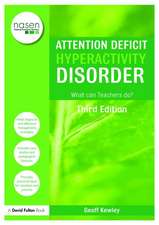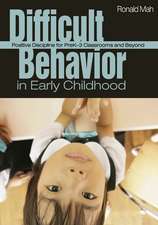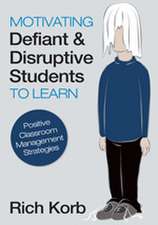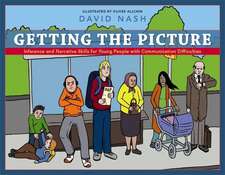Managing the Cycle of Acting-Out Behavior in the Classroom
Autor Geoffrey T. Colvin, Terrance M. Scotten Limba Engleză Paperback – 3 feb 2015
Acting-out behavior by students manifests in ways that make classroom management and academic success very challenging.
In this time- and field-tested resource, Colvin and Scott present a system for understanding acting–out behavior in terms of seven phases and correcting it before it gets in the way of student engagement and learning. The newly updated edition draws on the latest research to deliver a clear roadmap for educators to assess acting-out behavior and to design effective interventions in a clear, systematic, and achievable matter.
Rooted in applied behavior analysis, sound instructional principles, and functional behavior assessment, Colvin and Scott’s method includes:
- Strategies for each phase of the acting-out cycle—from structuring the classroom, to managing agitation and escalated behavior, to recovery
- Case studies that distill concrete action steps from the book’s concepts
- Checklists, tools, resources, and templates for applying the book’s principles to any classroom.
No educator should be without this definitive guide to classroom management and social skill development that sets the stage for student success in school.
Preț: 277.83 lei
Nou
Puncte Express: 417
Preț estimativ în valută:
53.16€ • 55.65$ • 44.25£
53.16€ • 55.65$ • 44.25£
Carte disponibilă
Livrare economică 10-24 martie
Livrare express 21-27 februarie pentru 30.90 lei
Preluare comenzi: 021 569.72.76
Specificații
ISBN-13: 9781483374369
ISBN-10: 148337436X
Pagini: 264
Ilustrații: illustrations
Dimensiuni: 178 x 254 x 22 mm
Greutate: 0.48 kg
Ediția:Second Edition
Editura: SAGE Publications
Colecția Corwin
Locul publicării:Thousand Oaks, United States
ISBN-10: 148337436X
Pagini: 264
Ilustrații: illustrations
Dimensiuni: 178 x 254 x 22 mm
Greutate: 0.48 kg
Ediția:Second Edition
Editura: SAGE Publications
Colecția Corwin
Locul publicării:Thousand Oaks, United States
Recenzii
"This book is a must-have resource for any classroom teacher in today’s school setting. The authors have translated decades of behavioral research into teacher relevant language and provided real-world examples of how the behavioral support concepts and strategies work. It includes helpful curriculum ideas, tables, classroom tools, and visuals for students. This book will be my new “go-to” resource on helping students with challenging behaviors."
"This book is a 'must have' resource for any teacher looking for a straightforward approach to teaching students how to manage their own behavior. Colvin and Scott have developed a guide that provides teachers with the clear steps and tools to dramatically impact student behavior in any classroom. "
"This book is a 'must have' resource for any teacher looking for a straightforward approach to teaching students how to manage their own behavior. Colvin and Scott have developed a guide that provides teachers with the clear steps and tools to dramatically impact student behavior in any classroom. "
Cuprins
Introduction
Section One: A Proactive Approach
1. A Proactive Approach - Emphasizing Student Success
Section Two: A Model
2. Analyzing Acting-Out Behavior
3. A Seven-Phase Model for Describing Acting-Out Behavior
Section Three: Strategies for Managing Each Phase of the Acting-Out Cycle
4. Structuring the Classroom to Enhance Instruction, Phase 1
5. Instructional Practices for Engaging Students, Phase 1
6. Precorrection Strategies for Triggers, Phase 2
7. Functional Behavioral Assessment for Triggers, Phase 2
8. Teaching Social Skills for Managing Triggers, Phase 2
9. Calming Strategies for Managing Agitation, Phase 3
10. Defusing Strategies for Managing Acceleration, Phase 4
11. Safe Management Strategies for Peak Behavior, Phase 5
12. Reintegration Strategies for De-escalation, Phase 6
13. Resumption Strategies for Recovery, Phase 7
Section Four: Closing
14. Summary and Case Study
Appendices
References
Section One: A Proactive Approach
1. A Proactive Approach - Emphasizing Student Success
Section Two: A Model
2. Analyzing Acting-Out Behavior
3. A Seven-Phase Model for Describing Acting-Out Behavior
Section Three: Strategies for Managing Each Phase of the Acting-Out Cycle
4. Structuring the Classroom to Enhance Instruction, Phase 1
5. Instructional Practices for Engaging Students, Phase 1
6. Precorrection Strategies for Triggers, Phase 2
7. Functional Behavioral Assessment for Triggers, Phase 2
8. Teaching Social Skills for Managing Triggers, Phase 2
9. Calming Strategies for Managing Agitation, Phase 3
10. Defusing Strategies for Managing Acceleration, Phase 4
11. Safe Management Strategies for Peak Behavior, Phase 5
12. Reintegration Strategies for De-escalation, Phase 6
13. Resumption Strategies for Recovery, Phase 7
Section Four: Closing
14. Summary and Case Study
Appendices
References
Notă biografică
Descriere
Minimize problem behavior and maximize student success!
Acting-out behavior by students manifests in ways that make classroom management and teaching very challenging.
Building on a model using seven phases of acting-out behavior presented in the first edition, the newly updated edition draws on new research in applied behavior analysis, sound instructional principles, and functional behavior assessment to deliver a clear roadmap for educators to design interventions in a clear, systematic, and achievable matter. Features include:
Acting-out behavior by students manifests in ways that make classroom management and teaching very challenging.
Building on a model using seven phases of acting-out behavior presented in the first edition, the newly updated edition draws on new research in applied behavior analysis, sound instructional principles, and functional behavior assessment to deliver a clear roadmap for educators to design interventions in a clear, systematic, and achievable matter. Features include:
- Managing each phase of the acting-out cycle—from structuring the classroom, to handling escalated behavior, to recovery
- Case studies that distill concrete action steps from the book’s concepts
- Checklists, tools, resources, and templates for applying the book’s principles to any classroom














